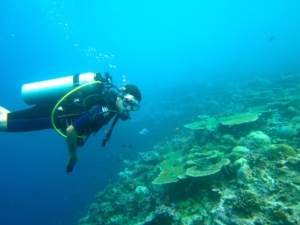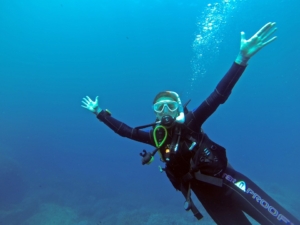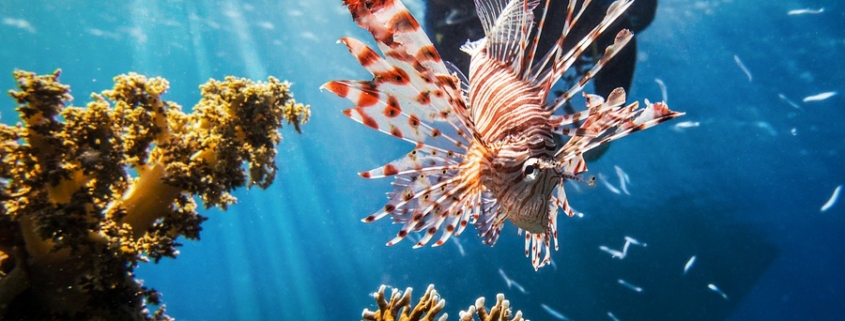Diving is a fun and memorable recreational activity that’s enjoyed by millions of people throughout the world. With that said, it isn’t without risks. According to the Professional Association of Diving Instructors (PADI), 50 people were killed while diving in 2014. While the rate of fatality among divers is low compared to other recreational activities — including jogging, swimming and horseback riding — fatalities can and do occur. Regardless of where you’re planning to dive, you should follow these 10 essential tips for safe diving.
#1) Don’t Hold Your Breath
For a safe dive, you must breathe properly while underwater by inhaling and exhaling just as you normally do on land. Inexperienced divers tend to hold their breath. After all, it’s only natural to hold your breath when you’re swimming dozens of feet below the surface. When you hold your breath, though, air will remain trapped inside your lungs. As you ascend, this air will expand while subsequently creating pressure. If the pressure becomes too high, the lining of your lungs — known as the alveoli — may rupture.
#2) Use a Surface Marker Buoy
Always use a surface marker buoy when diving to mark your location. Also known simply as a blog, a surface marker buoy is a floating device that’s intended to mark a diver’s location. They typically look like bright- or red-colored pool noodles that, when deployed, float the surface. Surface marker buoys are connected to the diver by a string or rope. When diving, you’ll tow the string or rope, allowing the surface marker buoy to move with you. If a boat happens to pass by while you are underwater, the captain will know that you are diving nearby by the presence of the surface marker buoy. As a result, you should get into the habit of deploying a surface marker buoy each time you dive.
#3) Carry Line Cutters
 Why should you carry line cutters when diving? Well, there’s an unfortunate amount of debris littering the oceans. In addition to trash, you’ll probably discover fishing lines and nets floating about. If you happen to get tangled in a line or net, you may struggle to escape. Using a pair of line cutters, however, you can cut the line or net. Some divers carry a knife instead of line cutters, but line cutters are typically safer to use because of their enclosed design. They feature two blades that are shielded with plastic. To cut a line or net, simply place it through the narrow opening of the line cutters, at which point the two blades should cut through it.
Why should you carry line cutters when diving? Well, there’s an unfortunate amount of debris littering the oceans. In addition to trash, you’ll probably discover fishing lines and nets floating about. If you happen to get tangled in a line or net, you may struggle to escape. Using a pair of line cutters, however, you can cut the line or net. Some divers carry a knife instead of line cutters, but line cutters are typically safer to use because of their enclosed design. They feature two blades that are shielded with plastic. To cut a line or net, simply place it through the narrow opening of the line cutters, at which point the two blades should cut through it.
#4) Log Your Dives
Logging your dives can reduce the risk of injury when diving. In a dive log, you’ll record specific information about the dive. The header section, for example, allows you to record the date, time and location of the dive, whereas the equipment section allows you to record the type of equipment used during the dive. There’s even a comments section where you can record any other pertinent or otherwise important information. By completing a dive log after each dive, you’ll have a better understanding of what to expect during future dives. You can also use this information to better prepare yourself. If you were uncomfortably cold during a dive, as recorded in the dive log, perhaps you can wear a thicker wetsuit the next time you dive in similar conditions. Alternatively, if you found yourself running low on air, as recorded in the dive log, you can bring a larger air supply.
#5) Partner Up
There’s safety in numbers, and diving is no exception. As explained in a previous blog post, diving with a buddy is inherently safer than diving alone. If you dive alone, also known as solo diving, you won’t have anyone to assist you if a hazard or emergency occurs. If your regulator stops working, for example, you’ll have to resurface without access to fresh air. If you dive with a buddy, on the other hand, he or she can provide you with their regulator. That doesn’t necessarily mean that solo diving is dangerous. Rather, the risk of injury is lower when diving with a buddy because there’s someone to watch your back at all times.
#6) Follow the Rule of Thirds
What is the rule of thirds, and why should you follow it when diving? The rule of thirds is an air consumption rule stating that you should use no more than one-third of your air supply when descending and one-third when ascending during the return. Of course, that still leaves one-third of your total air supply remaining, which is intended as a reserve supply. If you don’t follow the rule of thirds, you may inadvertently consume too much air, resulting in a dwindling air supply that may be insufficient for your ascent to the surface. The rule of thirds ensures that you always extra air in case of an emergency.
#7) Know Hand Signals
Assuming you dive with a buddy, you’ll need to know how to communicate using hand signals. When you’re underwater, you probably won’t be able to communicate using your voice. Instead, you’ll need to use hand signals. Over the years, certain hand signals have become synonymous with specific messages when diving. The thumbs-up signal, for example, indicates that you want to ascend, whereas the thumbs-down signal indicates that you want to descend. For more information on diving hand signals, as well as other forms of underwater communication, click here.
#8) Relax Your Body
 Keep your body relaxed when diving so that you don’t consume an excessive amount of air. Some divers are guilty of tensing their body. When your body is tense, however, your respiratory rate will increase, meaning you’ll consume more air. At the same time, tensing your body will restrict your ability to swim and navigate. It may take a little practice, but you must learn to relax your diving when diving. By keeping your body relaxed, you’ll be able to breathe and swim more efficiently, which may lower your risk of injury.
Keep your body relaxed when diving so that you don’t consume an excessive amount of air. Some divers are guilty of tensing their body. When your body is tense, however, your respiratory rate will increase, meaning you’ll consume more air. At the same time, tensing your body will restrict your ability to swim and navigate. It may take a little practice, but you must learn to relax your diving when diving. By keeping your body relaxed, you’ll be able to breathe and swim more efficiently, which may lower your risk of injury.
#9) Ascend Slowly
It’s important to ascend slowly, especially when diving at deep depths. Most diving experts recommend ascending no faster than 30 feet per minute. During the ascent, you should also stop every 15 feet for about three or four minutes. When ascending, your body will release nitrogen from its blood and tissues. If you ascend too quickly, the trapped nitrogen will expand, which could lead to a serious and potentially fatal medical condition known as the bends or decompression sickness. To prevent this from happening, you must ascend slowly, especially when diving at deep depths.
#10) Get Certified
If you’re serious about diving and want to take your skills to the next level, consider taking a diving certification course. PADI offers a variety of certification courses, some of which include Open Water Diver, Advanced Water Diver, Rescue Diver, Master Scuba Diver, Divemaster and Adaptive Support Diver. Alternative, Scuba Diving International (SDI) offers courses like Open Water Scuba Diver. Each of these courses focuses on a specific curriculum. However, they will all help you become a better, safer diver. Just remember to log your dives, as many certification courses require a minimum number of logged and verified dives to enroll.
Want to create your own custom dive logs? Contact us today to learn more about our custom dive logs.



